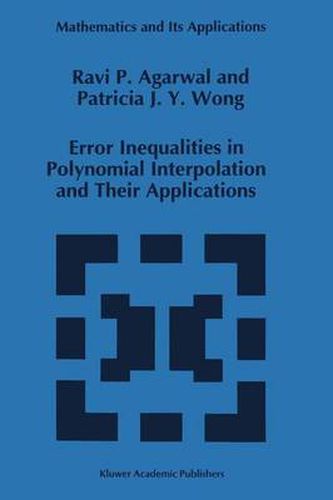Readings Newsletter
Become a Readings Member to make your shopping experience even easier.
Sign in or sign up for free!
You’re not far away from qualifying for FREE standard shipping within Australia
You’ve qualified for FREE standard shipping within Australia
The cart is loading…






This title is printed to order. This book may have been self-published. If so, we cannot guarantee the quality of the content. In the main most books will have gone through the editing process however some may not. We therefore suggest that you be aware of this before ordering this book. If in doubt check either the author or publisher’s details as we are unable to accept any returns unless they are faulty. Please contact us if you have any questions.
Given a function x(t) E c{n) [a, bj, points a = al < a2 < …< ar = b and subsets aj of {0,1, ‘,n -1} with L:j=lcard(aj) = n, the classical interpolation problem is to find a polynomial P - (t) of degree at most (n - 1) n l such that P~~l(aj) = x{i)(aj) for i E aj, j = 1,2, r. In the first four chapters of this monograph we shall consider respectively the cases: the Lidstone interpolation (a = 0, b = 1, n = 2m, r = 2, al = a2 = {a, 2 , 2m - 2}), the Hermite interpolation (aj = {a, 1,’ , kj - I}), the Abel - Gontscharoff interpolation (r = n, ai ~ ai+l, aj = {j - I}), and the several particular cases of the Birkhoff interpolation. For each of these problems we shall offer: (1) explicit representations of the interpolating polynomial; (2) explicit representations of the associated error function e(t) = x(t) - Pn-l(t); and (3) explicit optimal/sharp constants Cn,k so that the inequalities k I e{k)(t) I < C k(b -at- max I x{n)(t) I, 0 n - 1 n -, a$t$b - are satisfied. In addition, for the Hermite interpolation we shall provide explicit opti- mal/sharp constants C(n,p, v) so that the inequality II e(t) lip:::; C(n,p, v) II x{n)(t) 1111, p, v ~ 1 holds.
$9.00 standard shipping within Australia
FREE standard shipping within Australia for orders over $100.00
Express & International shipping calculated at checkout
Stock availability can be subject to change without notice. We recommend calling the shop or contacting our online team to check availability of low stock items. Please see our Shopping Online page for more details.
This title is printed to order. This book may have been self-published. If so, we cannot guarantee the quality of the content. In the main most books will have gone through the editing process however some may not. We therefore suggest that you be aware of this before ordering this book. If in doubt check either the author or publisher’s details as we are unable to accept any returns unless they are faulty. Please contact us if you have any questions.
Given a function x(t) E c{n) [a, bj, points a = al < a2 < …< ar = b and subsets aj of {0,1, ‘,n -1} with L:j=lcard(aj) = n, the classical interpolation problem is to find a polynomial P - (t) of degree at most (n - 1) n l such that P~~l(aj) = x{i)(aj) for i E aj, j = 1,2, r. In the first four chapters of this monograph we shall consider respectively the cases: the Lidstone interpolation (a = 0, b = 1, n = 2m, r = 2, al = a2 = {a, 2 , 2m - 2}), the Hermite interpolation (aj = {a, 1,’ , kj - I}), the Abel - Gontscharoff interpolation (r = n, ai ~ ai+l, aj = {j - I}), and the several particular cases of the Birkhoff interpolation. For each of these problems we shall offer: (1) explicit representations of the interpolating polynomial; (2) explicit representations of the associated error function e(t) = x(t) - Pn-l(t); and (3) explicit optimal/sharp constants Cn,k so that the inequalities k I e{k)(t) I < C k(b -at- max I x{n)(t) I, 0 n - 1 n -, a$t$b - are satisfied. In addition, for the Hermite interpolation we shall provide explicit opti- mal/sharp constants C(n,p, v) so that the inequality II e(t) lip:::; C(n,p, v) II x{n)(t) 1111, p, v ~ 1 holds.